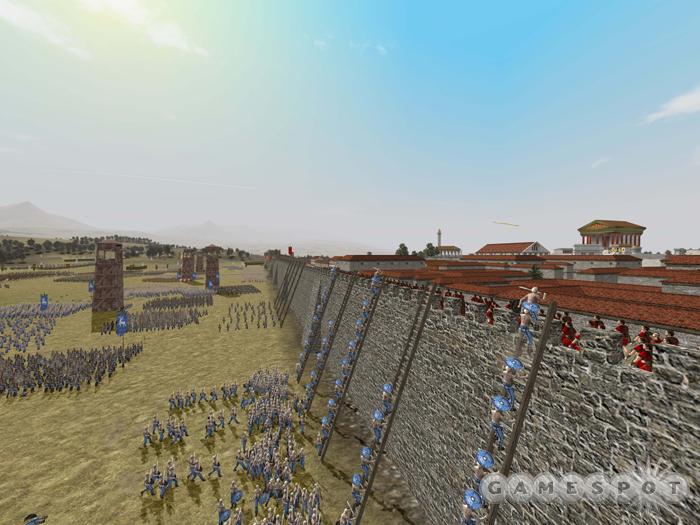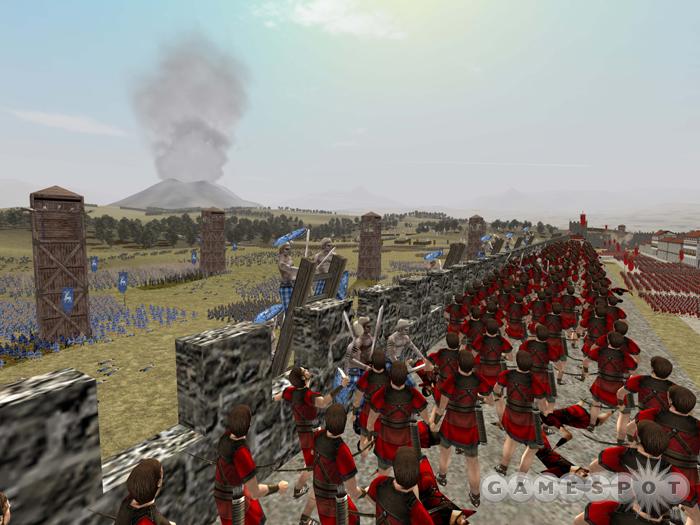Rome: Total War Designer Diary #3
Lead programmer Jerome Grasdyke talks about polishing Rome: Total War as it slowly nears completion.
Like the battle scenes in movies, the battles in games have become more and more epic. The perfect example of this is Rome: Total War, the upcoming strategy game from developer Creative Assembly. The third title in the Total War series, Rome will allow you to command thousands upon thousands of 3D-rendered men on the battlefields of the ancient, classical world. With infantry, cavalry, archers, and more under your command, it's your job to use tactics to crush the enemy. And when you're not waging battles, you'll use the game's beautiful strategic map to plan your conquest of the known world. The game is scheduled for release this fall, and, as lead programmer Jerome Grasdyke explains in our latest designer diary, Creative Assembly is currently polishing the game and stamping out any last-minute bugs.

Polishing Rome
By Jerome GrasdykeLead Programmer
After an eventful run up to E3, the Rome team is now back on the beta trail, ironing the last of the bugs and unintentional gameplay "features" from the game. This long process involves almost as much design tweaking as correcting coding errors, but it is where you get the real magic of games development. The early stages of a project are usually equal parts careful planning and engineering efforts, and they carry themselves through--almost automatically--on sheer enthusiasm for new and wonderful things. But when it has all come together, you start to see the rough edges where things don't quite fit right or are not as smooth as they could be. Getting from there to a final product can be frustrating, ecstatic, exhausting, argumentative, uplifting, occasionally boring, and, every now and then, seemingly just plain impossible. And sometimes--just sometimes--you find an unexpected gem, where the game starts doing things you didn't predict.
At the start of the project, we set out to create a battlefield that was larger, more immersive, and more interesting to play on than those in earlier Total War games. The "larger" part was by far the easiest, since this part of the earlier games was mostly limited by hardware constraints, such as the amount of memory in the machine and the number of landscape polygons that could be pushed through the engine. Hardware has come a very long way in the last few years, and the Rome engine now pushes upwards of 1.5 million polygons per frame, with the detail turned all the way up. And Rome is also larger in other ways. The cities are bigger, the colors more intense--no, really--and there are many more, varied unit types. We've put a lot of effort into creating a world that feels expansive and gives you a real sense of scale and freedom.
In some ways, this was one of the most rewarding parts of the project to work on. There is this duality in most games between a gameplay-focused environment and a simulation. You could think of this as the difference between Tetris and Microsoft Flight Simulator. The first is a nonsense environment that exists just for fun and is a place where the game designer's imagination can run riot, while the other makes a solid attempt to model parts of the real world. But in modern games, this line is blurring. Modern games contain physics systems and software models for things, such as car engines or guns, and half the game is built around these. Much of Rome's landscape and environment is built out of simulation elements in a similar way. For programmers, this kind of work is a lot of fun, because you can get as much information from the real world as you need. Furthermore, what you're trying to achieve is clear, and it's a challenge to get as close as possible to the real thing.
When Pigs Burn
Increasing the immersion, on the other hand, has been a much more complex business. It's the touchy-feely part of games development, where you end up gauging the public's reaction to added features, and emotional judgment is paramount. Moving to 3D soldiers was a part of this, but we've added many little touches that all make a bit of difference, which includes unit officers, for one. Not every unit has officers, but they are often historically significant when they do appear. Take the buccinators, ("horn blowers") who accompany Legionary First Cohort units, or the aquilifers, who carry the Legionary Eagles. These units have their own special formation positions near the men they accompany, and, hence, on the field it actually looks like a troop of soldiers with their commanders. Take a step back, and suddenly you see the whole as an army. 
The general appears on the battlefield in a similar way--as an officer commanding his bodyguards while gesturing to his troops to urge them on as you issue orders to the units in the army. We've also added different kinds of idles and, of course, many more, varied ways for the unfortunate soldiers to die. The "burning pigs," which are surely infamous by now, have acquired the ability to set other troops on fire. Drowning has recently been added as well, for the very rare circumstance where a soldier falls into the water.
Another major new addition on the immersion front is the prebattle speech given by the general. These motivational talks to the troops pull in an awful lot of contextual information about the battle. For example, the speech can contain such gems as, "The enemy hordes stand before us, outnumbering us many times, and a long battle awaits. I shall be commanding from the rear." This last sentence will actually be muttered should your general have acquired the cowardice vice during campaign play. This is, of course, accompanied by much taunting and waving of rude gestures at the enemy by the soldiers. I'm not entirely sure whether the baring of the buttocks will survive the cut of the censor's knife, though. There is such a thing as too much immersion.
Making the game more interesting for the players, in the end, came down to managing variety--especially with regard to units and landscape elements--and it paradoxically also came down to removing some options that were present in the earlier games. The previous Total War games had many buttons to push for each unit and all the things each unit could do. All of this added up to a lot of things for the player to consider. Sometimes it made it hard for the player to see what exactly the best course of action was. In Rome, much of this is streamlined. Some of it is tucked away in the artificial intelligence assist functions, and some has been designed out of existence. This has also added some really cool extra things, like the Cantabrian Circle special ability (for the horse archers), the phalanxes, and so on, without overloading the player.
That's it for this designer diary. Next time we'll talk in more detail about the game's campaign map.
Got a news tip or want to contact us directly? Email news@gamespot.com
Join the conversation